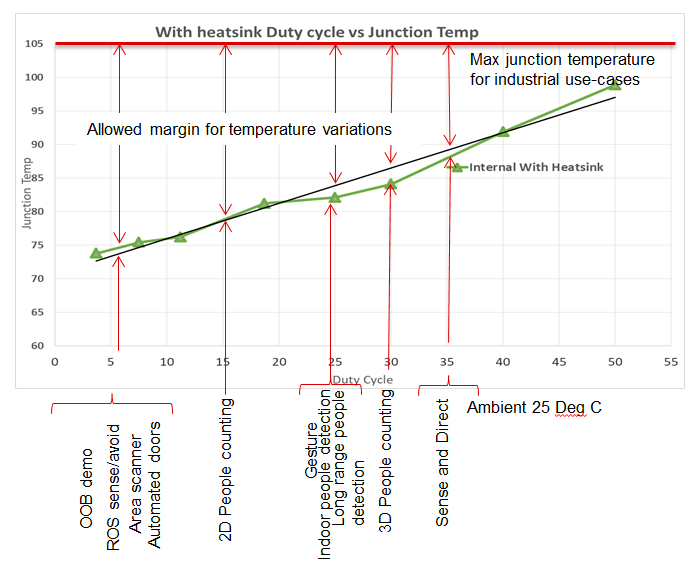SWRA672 May 2020 AWR6843AOP , IWR6843AOP
6 Application and Demos
Table 4 lists some of the example demos and its chirp design duty cycles. These demos could be configurable depending upon performance requirement from end equipment point of view.
Table 4 illustrates that the EVM allows a maximum temperature without any further thermal mitigation techniques (such as board size increase, thermal interface material or without any enclosure design) for various demo configurations. With additional thermal improvement techniques (heatsink), the maximum allowed temperature can be taken higher.
Table 4. Various TI mmWave Demos and Its Duty Cycles
| Demo Examples | Duty Cycle (1) | Margin to 105°C(3) | Max Temp Allowed in °C (from 25°C)(3) | EVM (Mission section only) | Simulated square board size (1) | EVM (Mission + Break-away) | EVM (Mission + Break-away) | Simulated square board size(2) |
|---|---|---|---|---|---|---|---|---|
| Board size | 540 Sq mm | 1600 sq mm | 1759 Sq mm | 1759 Sq mm | 2500 sq mm | |||
| Heatsink | No | No | No | Yes | No | |||
| Sense and Direct | <35% | 17 | 42 | - | √ | - | √ | √ |
| 3D People Counting | >29% | 21 | 46 | - | √ | - | √ | √ |
| Outdoor (Long Range) People counting | >25% | <23 | 48 | - | √ | - | √ | √ |
| Gesture | ~25% | 23 | 48 | - | √ | √ | √ | √ |
| Indoor People Counting | >25% | <23 | 48 | - | √ | √ | √ | √ |
| Automated Door | <10% | 32 | 57 | √ | √ | √ | √ | √ |
| Area scanner: | <10% | 32 | 57 | √ | √ | √ | √ | √ |
| ROS sense/avoid | <10% | 32 | 57 | √ | √ | √ | √ | √ |
| OOB demo | <10% | 32 | 57 | √ | √ | √ | √ | √ |
- Based on Thermal simulation data estimate only with ~15°C margin to 105°C.
- Based on Thermal simulation data estimate only with ~20°C margin to 105°C.
- These column refer to EVM (Mission + Break-away) with sheet metal heatsink.
Figure 22 shows junction temperature in °C vs % duty cycle. In the graphs various demos are mapped to X-axis indicating its duty cycle used for the demonstration.
It can be seen at lower duty cycle cases, lower power consumption from the sensor is expected, hence it would allow maximum operating temperature margin. At higher duty-cycles sensor power, dissipation is higher, hence the allowed maximum operating temperature margin would be lower. This is a rough guidance on how duty cycle and power dissipation could be traded-off to arrive at the right operating junction temperature. Tick marks indicate lower duty-cycled cases. The EVM has a sufficient thermal margin to operate at higher duty-cycled cases, further thermal considerations (such as heatsink) are needed.
 Figure 22. Thermal Characteristics of Various Demos Under Its Operating Conditions
Figure 22. Thermal Characteristics of Various Demos Under Its Operating Conditions